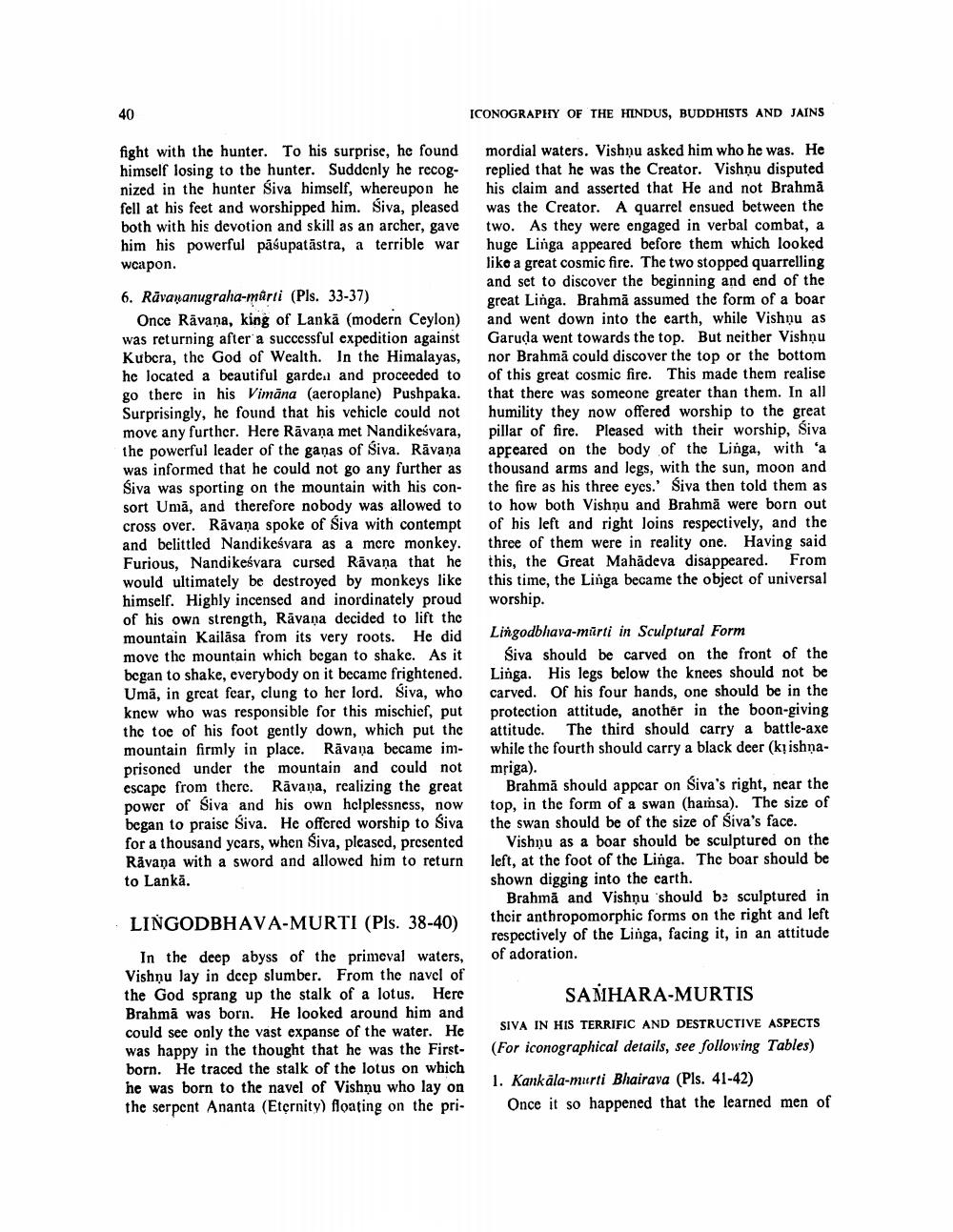________________
40
ICONOGRAPHY OF THE HINDUS, BUDDHISTS AND JAINS
fight with the hunter. To his surprise, he found himself losing to the hunter. Suddenly he recognized in the hunter Siva himself, whereupon he fell at his feet and worshipped him. Siva, pleased both with his devotion and skill as an archer, gave him his powerful pāśupatāstra, a terrible war wcapon.
6. Rāvananugraha-marti (Pls. 33-37)
Once Rāvana, king of Lankā (modern Ceylon) was returning after a successful expedition against Kubcra, the God of Wealth. In the Himalayas, he located a beautiful garden and proceeded to go there in his Vimāna (aeroplane) Pushpaka. Surprisingly, he found that his vehicle could not move any further. Here Rāvana met Nandikeśvara, the powerful leader of the ganas of Siva. Rāvaņa was informed that he could not go any further as Siva was sporting on the mountain with his con- sort Umā, and therefore nobody was allowed to cross over. Rāvana spoke of Siva with contempt and belittled Nandikeśvara as a more monkey. Furious, Nandikeśvara cursed Rāvana that he would ultimately be destroyed by monkeys like himself. Highly incensed and inordinately proud of his own strength, Rāvana decided to lift the mountain Kailāsa from its very roots. He did move the mountain which began to shake. As it began to shake, everybody on it became frightened. Umā, in great fear, clung to her lord. Siva, who knew who was responsible for this mischief, put the toe of his foot gently down, which put the mountain firmly in place. Rāvana became im- prisoned under the mountain and could not escape from there. Rāvana, realizing the great power of Siva and his own helplessness, now began to praise Siva. He offered worship to Siva for a thousand years, when Siva, pleased, presented Råvana with a sword and allowed him to return to Lankā.
mordial waters. Vishnu asked him who he was. He replied that he was the Creator. Vishnu disputed his claim and asserted that He and not Brahma was the Creator. A quarrel ensued between the two. As they were engaged in verbal combat, a huge Linga appeared before them which looked like a great cosmic fire. The two stopped quarrelling and set to discover the beginning and end of the great Linga. Brahmă assumed the form of a boar and went down into the earth, while Vishnu as Garuda went towards the top. But neither Vishnu nor Brahmă could discover the top or the bottom of this great cosmic fire. This made them realise that there was someone greater than them. In all humility they now offered worship to the great pillar of fire. Pleased with their worship, Siva appeared on the body of the Linga, with 'a thousand arms and legs, with the sun, moon and the fire as his three eyes.' Siva then told them as to how both Vishnu and Brahmã were born out of his left and right loins respectively, and the three of them were in reality one. Having said this, the Great Mahadeva disappeared. From this time, the Linga became the object of universal worship.
Lingodbhava-murti in Sculptural Form
Śiva should be carved on the front of the Linga. His legs below the knees should not be carved. Of his four hands, one should be in the protection attitude, another in the boon-giving attitude. The third should carry a battle-axe while the fourth should carry a black deer (krishnampiga).
Brahmă should appear on Siva's right, near the top, in the form of a swan (hamsa). The size of the swan should be of the size of Siva's face.
Vishnu as a boar should be sculptured on the left, at the foot of the Linga. The boar should be shown digging into the earth.
Brahma and Vishnu should be sculptured in thcir anthropomorphic forms on the right and left respectively of the Linga, facing it, in an attitude of adoration.
· LINGODBHAVA-MURTI (Pls. 38-40)
In the deep abyss of the primeval waters, Vishnu lay in deep slumber. From the navel of the God sprang up the stalk of a lotus. Here Brahma was born. He looked around him and could see only the vast expanse of the water. He was happy in the thought that he was the Firstborn. He traced the stalk of the lotus on which he was born to the navel of Vishnu who lay on the serpent Ananta (Eternity) floating on the pri-
SANHARA-MURTIS SIVA IN HIS TERRIFIC AND DESTRUCTIVE ASPECTS (For iconographical details, see following Tables) 1. Kankāla-murti Bhairava (Pls. 41-42)
Once it so happened that the learned men of




